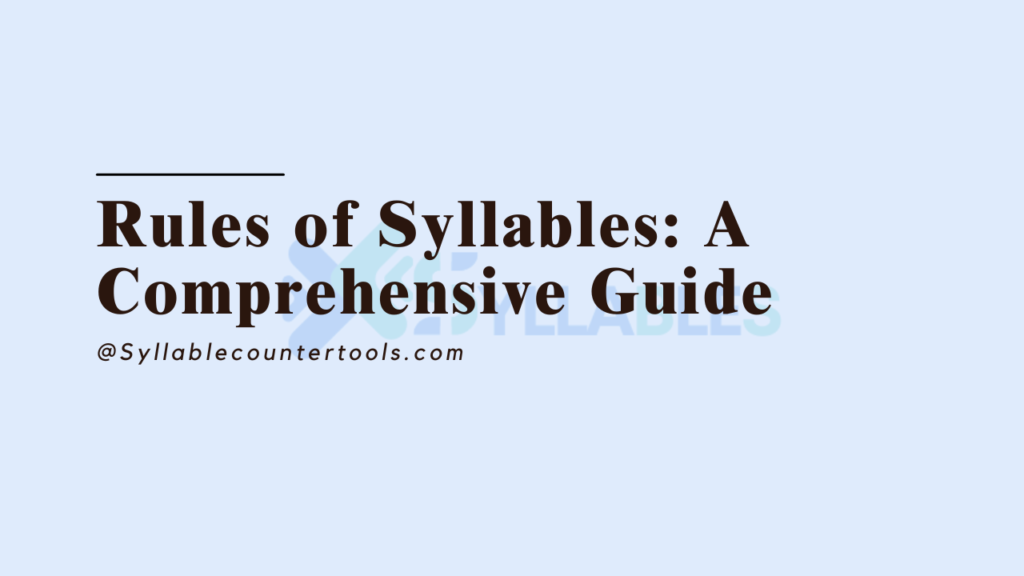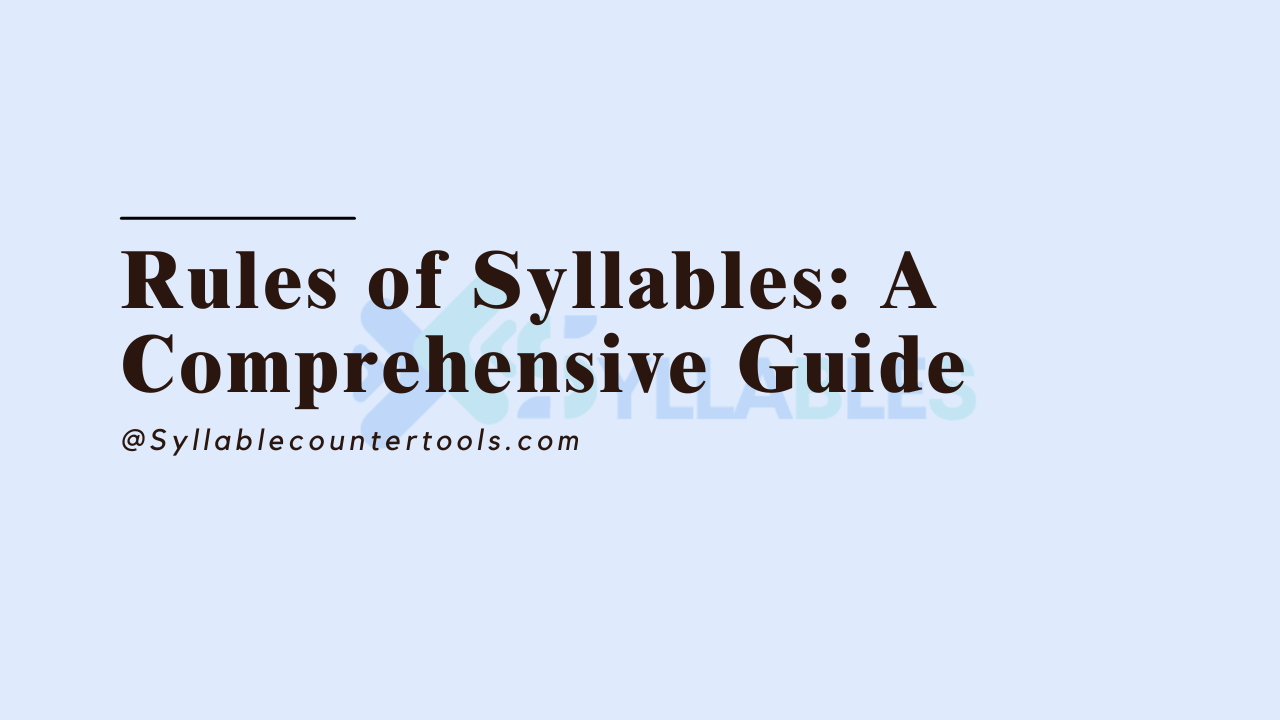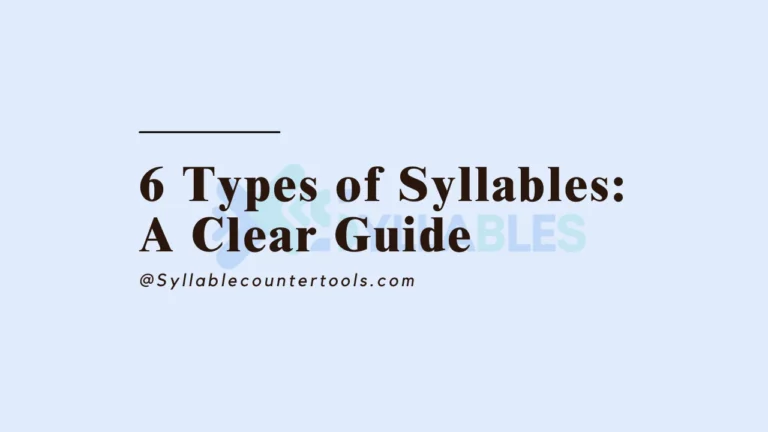Rules of Syllables Division: A Comprehensive Guide 2024
Have you ever wondered how words are broken down into their rhythmic components? That’s where the rules of syllables come into play. A syllable is the basic unit of pronunciation in language, forming the building blocks of words. Understanding how syllables work is essential to mastering not just pronunciation but also rhythm and structure in both speaking and writing.
The concept of syllables is fascinating because it serves as the foundation for understanding language patterns. In every word, the arrangement and number of syllables determine its flow, from the smoothness of a simple, single-syllable word to the complexity of multi-syllable phrases. For instance, while “cat” and “bat” are one-syllable words, “communication” and “imagination” stretch across multiple syllables, each adding a unique rhythm to the language.
Rules of syllables aren’t just important for linguists or language learners; they are essential for poets, songwriters, and anyone interested in the sounds of words. The way syllables are stressed and combined can change the meaning or tone of a phrase, which is why mastering rules of syllables can enhance your understanding of language in a powerful way.
In this article, we’ll dive deeper into the rules of syllables, exploring how they function, how to identify them in words, and why they are key to both written and spoken language. Whether you’re an aspiring poet, a student, or just someone intrigued by the way language works, understanding syllables is an indispensable part of mastering communication.
What Is a Syllable?
A syllable is a unit of sound within a word, typically containing a vowel sound, and it may be accompanied by consonants. For instance, in the word “apple”, there are two syllables: ap-ple. The vowel sound is always the central component of a syllable, with consonants surrounding it.
Why Are Syllables Important?
Impact on Pronunciation
Correct syllable stress is crucial for proper pronunciation. Stressing the wrong syllable can change the meaning of a word. For instance:
- “record” (noun) is stressed on the first syllable: RE-cord.
- “record” (verb) is stressed on the second syllable: re-CORD.
Misplacing stress can lead to misunderstandings, especially in languages like English, where stress patterns are essential for meaning.
Syllables in Reading and Writing
Syllables play a significant role in reading and spelling. By breaking words into syllables, learners can decode them more easily. For example, breaking “beautiful” into syllables: beau-ti-ful makes it easier to recognize and spell.
Syllables in Creativity
In poetry and songwriting, syllables determine rhythm, meter, and melody. A good understanding of syllables helps with creating balanced, harmonious lines in both forms of art.
How to Identify Syllables in Words?
Identifying syllables can be simple if you know the methods. Here are a few approaches:

Clapping Method
A practical method to count syllables is to clap for each distinct vowel sound. For example:
- “apple” has two syllables: ap-ple (clap, clap).
- “banana” has three syllables: ba-na-na (clap, clap, clap).
Vowel Sound Method
Each distinct vowel sound usually corresponds to one syllable. In the word “around”, you have three distinct vowel sounds, so it has three syllables: a-round.
Different Types of Syllables
Understanding syllable types is important for proper pronunciation and spelling. The four main types are:
Open Syllables
An open syllable ends with a vowel, which typically makes the vowel sound long. Examples include:
- “he”
- “no”
Closed Syllables
A closed syllable ends with a consonant, making the vowel sound short. Examples include:
- “cat”
- “dog”
Vowel-Consonant-e Syllables (VCe)
This type of syllable ends with a vowel and a silent “e”, often making the vowel sound long. Examples include:
- “cake”
- “bike”
Diphthong Syllables
A diphthong syllable contains two vowel sounds pronounced together, often making a complex sound. Examples include:
- “coin”
- “loud”
3 Rules Of Syllable Division
Knowing the basic rules of syllable division will help with correct spelling and pronunciation. Here are the main guidelines:
Every Syllable Contains a Vowel
A syllable must contain a vowel sound, which is the nucleus of the syllable. For example:
- “window” has two syllables: win-dow.
Divide Between Double Consonants
When two identical consonants appear together, divide them between the syllables. For example:
- “butter” divides as but-ter.
Prefix and Suffix Division
When dividing words with prefixes or suffixes, these parts should stay together. For example:
- “prefix” divides as pre-fix.
- “careful” divides as care-ful.
Why is it important to teach syllable division?
Teaching syllable division helps with reading, spelling, and pronunciation. It aids in breaking down complex words into manageable parts, improving fluency and understanding.
Strategies to teach syllabication rules:
- Use hands-on activities (e.g., clapping, tapping).
- Break down multisyllabic words into parts.
- Visual aids such as syllable division charts.
- Practice with word lists and repetition.
Syllable activities for teaching syllable separation:
- Syllable Sorting: Sort words into categories based on syllable count.
- Syllable Counting Games: Use flashcards to count syllables in various words.
- Clapping or Tapping: Clap or tap each syllable as you say a word.
- Syllable Segmentation: Write words on the board and ask students to identify and divide them into syllables.
Common Mistakes in Syllable Division

Miscounting Vowels
Make sure to count each distinct vowel sound in the word, not just the vowel letters. For example:
- “around” has three syllables: a-round (not two).
Ignoring Silent Letters
Silent letters, such as in “climb”, don’t affect syllable counts. The word “climb” has one syllable, despite the silent b.
Practice Exercises for Learning Syllables
To improve your understanding of syllables, here are some effective exercises:
Clapping Out Words
Clapping for each vowel sound is a fun way to practice. Start with simple words like “cat” and progress to longer words like “elephant”.
Syllable Games
Engage in word games like crosswords or syllable-based board games. This encourages learning syllable structures in a playful way.
Syllables in Poetry and Music
Syllables also influence the rhythm and flow of poetry and music. Here’s how:
Syllables in Poetry
Poetry often uses syllables to create meter, the rhythm that gives the poem its flow. For instance, iambic pentameter (common in Shakespearean poetry) follows a pattern of alternating stressed and unstressed syllables.
Syllables in Song Lyrics
Songwriters use syllables to fit lyrics to melodies. The arrangement of syllables affects how the song flows and how easy it is to sing.
This is the way to practice but according to ma today we dont need to do practice of it because we easily check syllables of word in any syllable counter toos. I always recommend to you our tool that is syllablecountertools(dot)com for better results.
Related Articles:
6 Types of Syllables: A Clear Guide
Conclusion:
Mastering syllables is fundamental to effective communication, proper pronunciation, and literacy. It’s a skill that enhances not only your everyday speech but also your ability to appreciate and create art, whether in poetry, songwriting, or other forms of creative writing.







